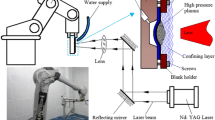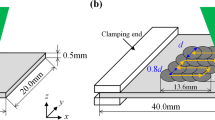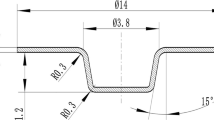Abstract
Laser shock forming (LSF) is an emerging method for metal sheet forming, and it can also be used to adjust the curvature of the curved metal. A series of laser shock adjustment experiments were conducted on 1-mm-thick curved aluminum 6061-T6 sheets using pulsed Nd3+:YAG laser operating at 1064-nm wavelength. The effects of various factors on the curvature adjustment were studied, including laser energy, impacted area, coverage rate of laser spots, and initial sheet shape. The mechanisms of curvature adjustment by LSF were studied by FEM simulation. The results have shown that the stress gradient mechanism and the shock bending mechanism were responsible for the two different kinds of deformation. The characteristic difference between the two mechanisms lies in whether the plastic deformation is directly induced on the bottom surface when the laser-induced shock wave is transmitted to the bottom surface. The curvature of the metal sheet can be adjusted conveniently within a certain range by changing the laser processing parameters, which is very useful for the engineering application.
















Similar content being viewed by others
References
Geiger M, Vollertsen F (1993) The mechanisms of laser forming. CIRP Ann Manuf Technol 42(1):301–304
Yilbas BS, Akhtar SS (2014) Laser bending of metal sheet and thermal stress analysis. Opt Laser Technol 61:34–44
Ueda T, Sentoku E, Wakimura Y, Hosokawa A (2009) Flattening of sheet metal by laser forming. Opt Lasers Eng 47(11):1097–1102
Ueda T, Wakimura Y, Furumoto T, Hosokawa A, Tanaka A (2011) Experimental investigation on laser flattening of sheet metal. Opt Lasers Eng 49(1):137–144
Hackel L, Harris F (2002) Contour forming of metals by laser peening. U.S. patent 6,410,884. 6-25
Hackel L, Chen HL (2003) Laser peening—a processing tool to strengthen metals or alloys. Laser Sci Technol Program 9:1–8
Edwards KR, Edwardson SP, Carey C, Dearden G, Watkins KG (2010) Laser micro peen forming without a tamping layer. Int J Adv Manuf Technol 47(1–4):191–200
Zhou J, Huang S, Fan Y, Jiang S, Xiao L, Sun Y, Chen Y (2008) Dynamical simulation and experimental study on laser peen forming of 6061-t6 aluminum alloy plate. Pacific International Conference on Applications
Hu Y, Xu X, Yao Z, Hu J (2010) Laser peen forming induced two way bending of thin sheet metals and its mechanisms. J Appl Phys 108(7):073117
Ding H, Cai L (2011) Sheet metal sizing method based on laser shock wave. Journal of J JIANGSU U:Nat Sci Ed 32(2):195–198
Ding K, Ye L (2003) FEM simulation of two sided laser shock peening of thin sections of Ti-6Al-4V alloy. Surf Eng 19(2):127–133
Johnson GR, Cook WH (1983) A constitutive model and data for materials subjected to large strains, high strain rates, and high temperatures. Proc. 7th Inf. Sympo. Ballistics 541-547
Manes A, Peroni L, Scapin M, Giglio M (2011) Analysis of strain rate behavior of an al 6061 t6 alloy. Procedia Eng 10:3477–3482
Berthe L, Fabbro R, Peyre P, Tollier L, Bartnicki E (1997) Shock waves from a water-confined laser-generated plasma. J Appl Phys 82:2826–2832
Braisted W, Brockman R (1999) Finite element simulation of laser shock peening. Int J Fatigue 21:719–724
Ding K, Ye L (2013) Three-dimensional dynamic finite element analysis of multiple laser shock peening processes. Surf Eng 19:351–358
Fabbro R, Fournier J, Ballard P, Devaux D, Virmont J (1990) Physical study of laser-produced plasma in confined geometry. J Appl Phys 68:775–784
Devaux D, Fabbro R, Tollier L, Bartnicki E (1993) Generation of shock waves by laser-induced plasma in confined geometry. J Appl Phys 74:2268–2273
Funding
This work was supported by Jiangsu Provincial Natural Science Foundation (Grant Number BEK20171297), Six talent peaks project in Jiangsu Province (grant Number GDZB-020), and Open Project Foundation of the State Key Laboratory of Mechanical System and Vibration, Shanghai JiaoTong University (Grant Number MSV-2015-17).
Author information
Authors and Affiliations
Corresponding author
Additional information
Publisher’s note
Springer Nature remains neutral with regard to jurisdictional claims in published maps and institutional affiliations.
Rights and permissions
About this article
Cite this article
Ye, Y., Zeng, R., Nie, Z. et al. Researches on the curvature adjustment of metal sheet induced by laser shock forming through experiments and simulations. Int J Adv Manuf Technol 108, 2791–2802 (2020). https://doi.org/10.1007/s00170-020-05469-6
Received:
Accepted:
Published:
Issue Date:
DOI: https://doi.org/10.1007/s00170-020-05469-6




